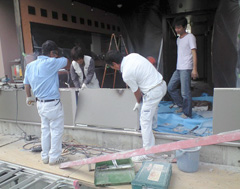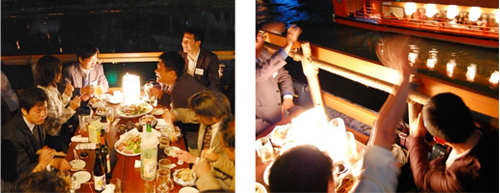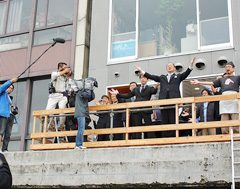|


Kitahama Terrace Project opening ceremony held on the morning of October 1, 2008. "Osaka-jime" hand-clapping ceremony was carried out both on the decking and on a boat.
In the summer of 2008, as the plan to build the first kawayuka decking along the banks of Osaka’s rivers began to look more realistic, members of the Kitahama Terrace Project were still confronted with a number of issues. While the project had found ways to comply with mandatory fire and building codes, it still needed to examine and decide how to construct, landscape, and design kawayuka decking that was unique to Osaka, and which, nobody had attempted before. The cost of building the decking was another major concern. The project committee, including citizens groups as well as the owners of buildings and restaurants, held countless meetings in order to search out the best course of action.
The kawayuka decking of Kyoto, on which the Kitahama Terrace Project has been modeled, is constructed using parts and materials that can be easily disassembled for storage when not in use. However, the Kitahama Terrace Project Committee knew that such a re-constructible system would be both costly and time-consuming to develop. Such a system would also need storage facilities when the decking was not in use. After repeated discussion of the issues, the committee concluded that their initial kawayuka decking should be both experimental and temporary, being able to be completely disassembled and removed after the conclusion of the event.
Taku Matsumoto, a member of “Suito Osaka-Mizubenomachi Saisei” Project, used his background and knowledge as an architect in designing kawayuka decking that was unique to Osaka. "Thinking in terms of the long-run, it is less costly to build something with a solid construction that can be reutilized in coming years,” says Matsumoto. "At the same time, however, I thought it was too risky to jump boots-first into this plan without being sure that the whole idea would work.” The Kitahama Terrace Project Committee eventually decided to establish the decking for a month only, using leased scaffolding materials for the decking frames, and wooden boards for the decking and handrail elements. For future usage, Matsumoto hopes to build full-scale kawayuka decking similar to that employed in Kyoto. "Pursuing such an approach will allow restaurants to operate their decking areas for a longer period of time. This fact alone should help in the recovery of building costs.”

Hidenobu Yamane is the owner of Y's Pier Kitahama Building, in which one of three participating restaurants, "Izayoi” (Osaka local cuisine), is located. While managing his real estate business, Yamane leads the nonprofit citizen group, “Osaka Machi Project,” and he has also been involved in various activities promoting the development of local communities. Yamane purchased the Y's Pier Kitahama Building about two years ago, after "falling in love with it at first sight." What particularly attracted Yamane to the building was both its great waterfront location and the building’s history. The building was formerly owned by “Kagairo,” one of the most renowned, authentic Japanese restaurants in the City of Osaka, whose main premises are now located immediately to the West of the Y's Pier Kitahama Building. “Kagairo” is known as the place where the famous Osaka Meeting* took place at the beginning of Meiji Era. For Yamane, who argues that Kitahama is the birthplace of modern Japan, it was not his experience as realtor, but rather his love of his hometown, that influenced him to buy the building.
Since purchasing the building, Yamane had been considering the addition of kawayuka decking. He explained his plan regarding such issues to the building tenants and received their agreement. There was, however, a problem. The riverside frontage of the building was not equipped with full glass doors, but rather consisted of a wall into which were set high-positioned windows. This was a feature that was difficult to convert into a doorway. Yamane needed to create a way by which to access the decking that he planned to install. He considered adding stairs or making another exit somewhere within the building. However, he finally settled on the bold idea of knocking down the entire wall and installing ceiling-high glass sliding doors in its place. It was a decision that proved Yamane's commitment to the kawayuka project as a participating building owner. The renovation of Yamane's building to replace the concrete wall with full glass doors made the building one of the highlights of the kawayuka project.

(left)Kawayuka at “Izayoi” restaurant viewed at night. The city's night view and breeze from the river make a perfect accompaniment to the drinks being served.
(right)A yakatabune (houseboat) passes by the decking, making a true scene of "water city."

Kitahama Terrace Project opening ceremony held on the morning of October 1, 2008. "Osaka-jime" hand-clapping ceremony was carried out both on the decking and on a boat.
Finally, in October, 2008, the dream of the Osaka's first kawayuka decking became a reality as the Kitahama Terrace Project opened to the public. Despite anxiety prior to opening, the three participating restaurants were packed continuously and fully-booked throughout the event. Osaka's newest waterfront destination was featured in various media outlets and also received acclaim from the governor. After a month of successful operation, the Terrace was closed as was originally planned, leaving many customers eagerly awaiting the next season. Leveraging feedback from this year’s experimentation, Osaka's kawayuka project intends full-scale operation in 2009, with even more restaurants and a longer period of operation. To support and promote the project, local communities have begun working to form a collaborative council.
A number of expectations have already been expressed regarding the future of the kawayuka project. Some have suggested establishing direct access for river boats to the kawayuka decking. Other people think it would be fun to include other services and programs within the project in addition to restaurant services. Some people feel the kawayuka project should operate all year round, while others believe that limited operation is better, turning the kawayuka project into the city’s newest seasonal attraction. With endless hopes and prospective ideas being expressed by local people and the communities in which they live, the Osaka kawayuka project continues to explore future possibilities.
*Osaka Meeting:
In 1875 (Meiji 8), Toshimichi Okubo, Takayoshi Kido, Taisuke Itagaki, and other important figures from the Meiji Government met at a restaurant in Kitahama, then named "Kagai." At the meeting, they discussed and determined key policies and principles for the nation's modern government. Topics discussed included the separation of the powers, the establishment of a bicameral parliamentary system, and the gradual establishment of the constitution. To celebrate the meeting’s accomplishments, Takayoshi Kido renamed the restaurant, "Kagairo" and wrote the new name in beautiful calligraphy.
It is believed that the original Kagairo building was located to the east of the current restaurant, approximately where the Y's Pier Kitahama Building stands today. To mark its historical significance, relief portraits of the Osaka Meeting attendees are displayed in the facade of the Y's Pier Kitahama Building.
|
